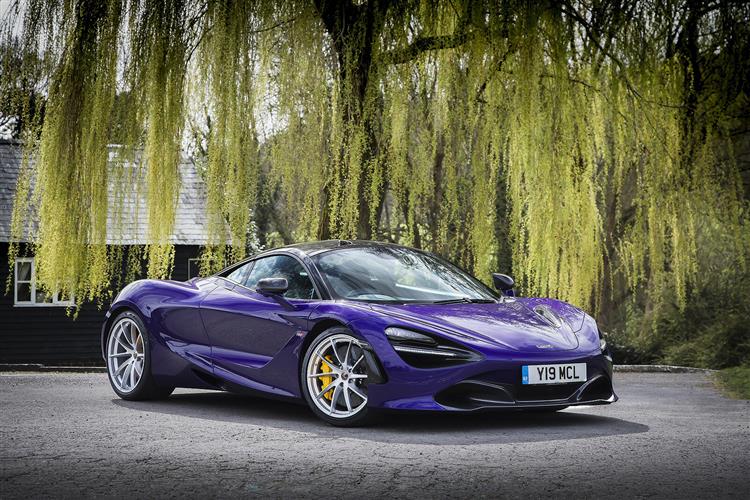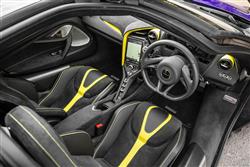ROARING TWENTIES (some text hidden) --NONE--
By Jonathan Crouch
Introductionword count: 38
The McLaren 720S claimed from launch to be the segment's most complete supercar. More capable, more compliant and more complete than anything the brand had previously brought us, in its era there was nothing else quite like it.
Modelsword count: 3
(2dr coupe, Spider)
Historyword count: 253
Back in 2017 at launch, the 720S was the most important model this British brand had ever made. It was the company's mid-range 'Super Series' model, positioned just above the Woking maker's 'Sports Series' 540C and 570S contenders. And the rare and exclusive 'Ultimate Series' McLaren Senna was positioned just above it. The 720S was priced against models like Ferrari's 488GTB and Lamborghini's Aventador, yet it offered performance worthy of a seven-figure hypercar in the class above. In other words, it set out to blur the boundaries and re-write the rulebook - in ways that we'll try and explain to you in this guide. Perhaps more importantly though, it aimed to redefine just how fast a road car could be - while still continuing to be credible form of conveyance, rather than a racer with a reg plate. The two earlier McLaren models that showed most promise in that regard were the cars that led the brand to this one - the MP4 of 2011 and its replacement the 650S of 2014. The 720S was the next stage in that evolution. It got an all-new carbonfibre chassis, revised suspension, a new-era cabin and a larger 4.0-litre twin turbocharged V8 engine developing 720PS, hence the model name. And it aimed to involve and satisfy you in a way that no competitor of its era could. A 720 Spider model joined the coupe version on late 2018 and 720S sales continued until the last quarter of 2023, when it was replaced by the faster 750S.
What You Getword count: 364
Street side presence: every supercar needs that: this one has it. The aluminium bodywork is shrink-wrapped around a carbon fibre structure to create a lean, sculpted shape that fuses visual drama, state-of-the-art technology and aerodynamic purity. Designer Rob Melville said it was inspired by the Great White Shark. We should talk about the dihedral doors; after all if you buy this car, your friends will. Here, they were not the same as the ones McLaren had offered before, the 80-degree opening angle being lower (to help in underground car parks) and requiring 155mm less space at the side than was the case with the lesser 570S model of this era, which increases accessibility when you're parked in tight spaces. As you'd expect, the central infotainment screen springs to life on entry, but the most eye-catching element is the Folding Driver Display which rotates into its fully open position as you take a seat. The primary hub for driver interaction though, is the Central Infotainment Screen, an 8-inch display that, thankfully, shares only its portrait format with the quirky 'IRIS' set-up the brand had previously used and been roundly criticised for - by us and others. A slim leather-stitched spur below this monitor incorporates the main controls for the 7-speed dual-clutch auto gearbox, while to the right of it lie the rotary controllers of the Active Dynamics Panel that'll be familiar to McLaren regulars. Perhaps the main thing though, that you'll carry away from a seat inside - and a short drive - is just how relatively easy it is to see out of this thing. Supercar owners used to claustrophobic rear cabin pillars or confining bulkheads will look around in amazement. The Monocage carbon fibre upper structure with its teardrop canopy allowed McLaren designers to specify strikingly slim roof pillars, while rearward vision is enhanced by transparent, glazed C-pillars and the way the V8 engine was mounted 145mm lower than it had been in the old 650S. Finally, boot space: in 720S models, this is all concentrated under the bonnet. This compartment is 150-litres in size, which of course is pretty small, but probably large enough to take a couple of airline-sized carry-on bags.
To see the full road test text contact us on 0330 0020 227
Pictures (high res disabled)

.jpg)
|
.jpg)
|
.jpg)
| |||
.jpg)
|
.jpg)
|
.jpg)
| |||
.jpg)
|
.jpg)
|

|
Scoring (subset of scores)
Category: Sporting Cars
| Performance | |
| Handling | |
| Comfort | |
| Space | |
| Styling, Build, Value, Equipment, Depreciation, Handling, Insurance and Total scores are available with our full data feed. | |



